Generac 005240, 005280, 005241, 005281, 005242 User Manual
...
Installation and
Owner's Manual
7, 10, 13 and 16kW Air-cooled, Automatic Standby Generators
C  US
US
LISTED
|
|
|
|
|
|
|
|
|
|
|
|
|
|
|
|
|
|
|
|
|
|
|
|
|
|
|
|
|
|
|
|
|
|
|
Not intended for use in critical life support |
Models: 005240, 005280 |
(6 kW NG, 7 kW LP) |
||||
napplications. |
005241, 005281 |
(9 kW NG, 10 kW LP) |
||||
Only qualified electricians or contrac- |
||||||
005242, 005282 |
(13 kW NG, 13 kW LP) |
|||||
ntors should attempt installation! Deadly |
||||||
exhaust fumes. Outdoor installation only! |
005243, 005244, (15 kW NG, 16 kW LP) |
|||||
|
005283, 005284 |
|
|
|||
www.generac.com or 1-888-GENERAC

Table of Contents |
|
|
Introduction............................................................. |
1 |
|
Read This Manual Thoroughly ............................................... |
1 |
|
Contents ............................................................................... |
1 |
|
Operation and Maintenance ................................................... |
1 |
|
How to Obtain Service........................................................... |
1 |
|
Authorized Dealer Locator Number............................................. |
1 |
|
Safety Rules ........................................................... |
2 |
|
Standards Index .................................................................... |
3 |
|
General Information................................................ |
4 |
|
1.1 |
Unpacking/Inspection ..................................................... |
4 |
1.2 |
Protection Systems ........................................................ |
4 |
1.3NEC Requirement for Arc Fault Circuit
|
Interruption Breaker for Bedrooms.................................. |
4 |
1.4 |
The Generator ................................................................ |
5 |
1.5 |
Specifications ................................................................ |
6 |
1.6 |
System Set LED ............................................................. |
7 |
1.7 |
Fuel Requirements and Recommendations ..................... |
7 |
1.8 |
Fuel Consumption .......................................................... |
7 |
1.9 |
Reconfiguring the Fuel System ....................................... |
8 |
1.10 |
Location......................................................................... |
9 |
1.11 |
Battery Requirements ................................................... |
10 |
1.12 |
Battery Installation........................................................ |
10 |
1.13 |
The Battery .................................................................. |
11 |
Post Installation Start-up and Adjustments .......... |
11 |
|
2.1 |
Before Initial Startup..................................................... |
11 |
2.2 |
Check Transfer Switch Operation.................................. |
12 |
2.3 |
Electrical Checks.......................................................... |
12 |
2.4 |
Generator Tests Under Load ......................................... |
12 |
2.5 |
Checking Automatic Operation...................................... |
13 |
2.6Adjusting the Fuel Regulator -
|
7kW (Natural Gas Only)................................................. |
13 |
2.7 |
Engine Governor Adjustment ........................................ |
14 |
2.8 |
Voltage Regulator Adjustment....................................... |
14 |
Operation .............................................................. |
15 |
|
3.1 |
Using the AUTO/OFF/MANUAL Switch .......................... |
15 |
3.2 |
Automatic Transfer Operation ....................................... |
15 |
3.3 |
Sequence of Automatic Operation................................. |
16 |
3.4 |
Manual Transfer Operation............................................ |
16 |
3.5 |
Setting the Exercise Timer ............................................ |
17 |
3.6 |
Protection Systems ...................................................... |
17 |
Maintenance ......................................................... |
18 |
|
4.1 |
Fuses........................................................................... |
18 |
4.2 |
Checking the Engine Oil Level....................................... |
19 |
4.3 |
Changing the Engine Oil ............................................... |
19 |
4.4 |
Changing the Engine Air Cleaner................................... |
20 |
4.5 |
Spark Plug(s)............................................................... |
21 |
4.6 |
Battery Maintenance..................................................... |
21 |
4.7 |
Adjusting GH-410/GT-530/990 Valve Clearance............. |
22 |
4.8 |
Cooling System............................................................ |
23 |
4.9 |
Attention After Submersion........................................... |
23 |
4.10 |
Corrosion Protection .................................................... |
23 |
4.11 |
Out of Service Procedure.............................................. |
23 |
4.12 |
Service Schedule ......................................................... |
25 |
Troubleshooting .................................................... |
26 |
|
5.1 |
Troubleshooting Guide.................................................. |
26 |
Notes .................................................................... |
27 |
|
Mounting Dimensions ........................................... |
30 |
|
Warranty ............................................................... |
32 |
|
AUTHORIZED
DEALER LOCATION
To locate the nearest AUTHORIZED DEALER, please call this number:
1-800-333-1322
DEALER LOCATION INFORMATION CAN BE OBTAINED AT THIS NUMBER or visit
www.guardiangenerators.com.
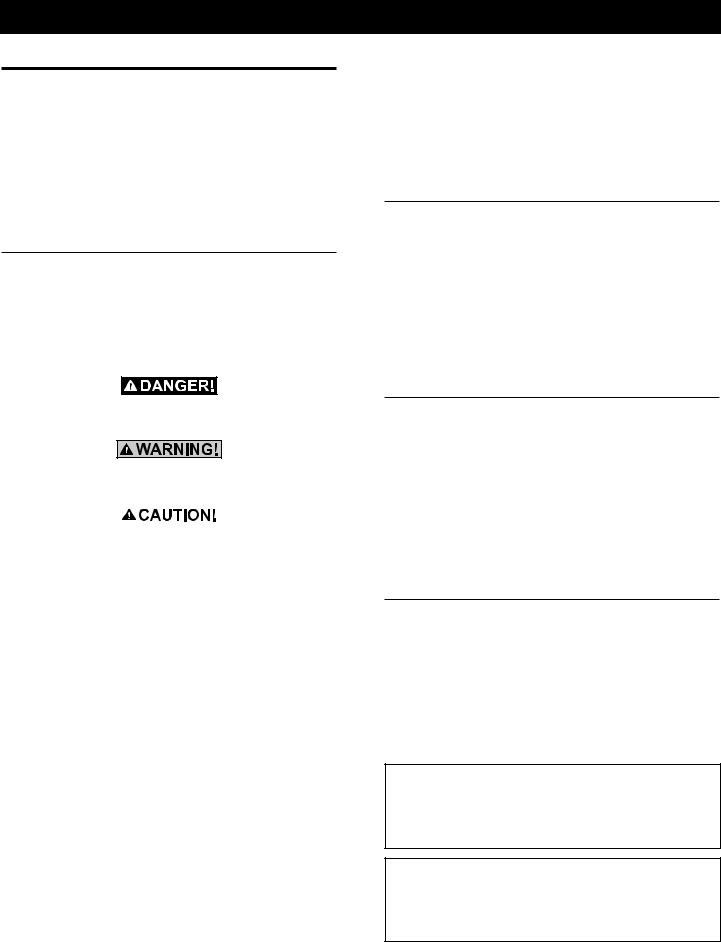
INTRODUCTION
Thank you for purchasing this model of the Guardian product line by Generac Power Systems Inc. This model is a compact, high performance, air-cooled, engine-driven generator designed to automatically supply electrical power to operate critical loads during a utility power failure.
This unit is factory installed in an all-weather, metal enclosure that is intended exclusively for outdoor installation. This generator will operate using either vapor withdrawn liquid propane (LP) or natural gas (NG).
READ THIS MANUAL THOROUGHLY
If any portion of this manual is not understood, contact the nearest Dealer for starting, operating and servicing procedures.
Throughout this publication, and on tags and decals affixed to the generator, DANGER, WARNING, CAUTION and NOTE blocks are used to alert personnel to special instructions about a particular operation that may be hazardous if performed incorrectly or carelessly. Observe them carefully. Their definitions are as follows:
INDICATES A HAZARDOUS SITUATION OR ACTION WHICH, IF NOT AVOIDED, WILL RESULT IN DEATH OR SERIOUS INJURY.
Indicates a hazardous situation or action which, if not avoided, could result in death or serious injury.
Indicates a hazardous situation or action which, if not avoided, could result in minor or moderate injury.
NOTE:
Notes contain additional information important to a procedure and will be found within the regular text body of this manual.
These safety warnings cannot eliminate the hazards that they indicate. Common sense and strict compliance with the special instructions while performing the action or service are essential to preventing accidents.
Four commonly used safety symbols accompany the DANGER, WARNING and CAUTION blocks. The type of information each indicates is as follows:
nThis symbol points out important safety information that, if not followed, could endanger personal safety and/or property of others.
This symbol points out potential explosion hazard.
This symbol points out potential fire hazard.
This symbol points out potential electrical shock hazard.
Introduction
The operator is responsible for proper and safe use of the equipment. The manufacturer strongly recommends that the operator read this Owner’s Manual and thoroughly understand all instructions before using this equipment. The manufacturer also strongly recommends instructing other users to properly start and operate the unit. This prepares them if they need to operate the equipment in an emergency.
CONTENTS
This manual contains pertinent owner’s information, including warranty, electrical diagrams, exploded views and lists of repair parts, for these different models:
•05240 & 05280 – 6 kW NG, 7 kW LP, single-cylinder GH-410 Engine
•05241 & 05281 – 9.0 kW NG, 10 kW LP, V-twin GT-530 Engine
•05242 & 05282 – 13 kW NG, 13 kW LP, V-twin GT-990 Engine
•05243, 05244, 05283 & 05284 – 15 kW NG, 16 kW LP, V-twin GT-990 Engine
OPERATION AND MAINTENANCE
It is the operator’s responsibility to perform all safety checks, to make sure that all maintenance for safe operation is performed promptly, and to have the equipment checked periodically by a Dealer. Normal maintenance service and replacement of parts are the responsibility of the owner/operator and, as such, are not considered defects in materials or workmanship within the terms of the warranty. Individual operating habits and usage contribute to the need for maintenance service.
Proper maintenance and care of the generator ensures a minimum number of problems and keep operating expenses at a minimum. See a Dealer for service aids and accessories.
HOW TO OBTAIN SERVICE
When the generator requires servicing or repairs, contact a Dealer for assistance. Service technicians are factory-trained and are capable of handling all service needs.
When contacting a Dealer about parts and service, always supply the complete model number and serial number of the unit as given on its data decal, which is located on the generator. See section “The Generator” for decal location.
Model No. _________________ Serial No.______________
CALIFORNIA PROPOSITION 65 WARNING
Engine exhaust and some of its constituents are known to the State of California to cause cancer, birth defects and other reproductive harm.
CALIFORNIA PROPOSITION 65 WARNING
This product contains or emits chemicals known to the State of California to cause cancer, birth defects and other reproductive harm.
1

Safety Rules
SAFETY RULES
nSave These Instructions – The manufacturer suggests that these rules for safe operation be copied and posted near the unit’s installation site. Safety should be stressed to all operators and potential operators of this equipment.
Study these SAFETY RULES carefully before installing, operating or servicing this equipment. Become familiar with this Owner’s Manual and with the unit. The generator can operate safely, efficiently and reliably only if it is properly installed, operated and maintained. Many accidents are caused by failing to follow simple and fundamental rules or precautions.
The manufacturer cannot anticipate every possible circumstance that might involve a hazard. The warnings in this manual, and on tags and decals affixed to the unit are, therefore, not all-inclusive. If using a procedure, work method or operating technique the manufacturer does not specifically recommend, ensure that it is safe for others. Also make sure the procedure, work method or operating technique utilized does not render the generator unsafe.
nDespite the safe design of this generator, operating this equipment imprudently, neglecting its maintenance or being careless can cause possible injury or death. Permit only responsible and capable persons to install, operate and maintain this equipment.
Potentially lethal voltages are generated by these machines. Ensure all steps are taken to render the machine safe before attempting to work on the generator.
nParts of the generator are rotating and/or hot during operation. Exercise care near running generators.
nInstallation must always comply with applicable codes, standards, laws and regulations.
nA running generator gives off carbon monoxide, an odorless, colorless poison gas. Breathing in carbon monoxide can cause headaches, fatigue, diziness, nausea, vomitting, confusion, fainting, siezures or death.
GENERAL HAZARDS
•For safety reasons, the manufacturer recommends that this equipment be installed, serviced and repaired by a Service Dealer or other competent, qualified electrician or installation technician who is familiar with applicable codes, standards and regulations. The operator also must comply with all such codes, standards and regulations.
•The engine exhaust fumes contain carbon monoxide, which can be DEADLY. This dangerous gas, if breathed in sufficient concentrations, can cause unconsciousness or even death. Do NOT alter or add to the exhaust system or do anything that might render the system unsafe or in noncompliance with applicable codes and standards.
•Install a battery operated carbon monoxide alarm indoors, according to manufacturer’s instructions/recommendations.
•Adequate, unobstructed flow of cooling and ventilating air is critical to correct generator operation. Do not alter the installation or permit even partial blockage of ventilation provisions, as this can seriously affect safe operation of the generator. The generator MUST be installed and operated outdoors only.
•Keep hands, feet, clothing, etc., away from drive belts, fans, and other moving or hot parts. Never remove any drive belt or fan guard while the unit is operating.
•When working on this equipment, remain alert at all times. Never work on the equipment when physically or mentally fatigued.
•Inspect the generator regularly, and contact the nearest Dealer for parts needing repair or replacement.
•Before performing any maintenance on the generator, disconnect its battery cables to prevent accidental start up. Disconnect the cable from the battery post indicated by a NEGATIVE, NEG or (–) first, then remove the POSITIVE, POS or (+) cable. When reconnecting the cables, connect the POSITIVE cable first, the NEGATIVE cable last.
•Never use the generator or any of its parts as a step. Stepping on the unit can stress and break parts, and may result in dangerous operating conditions from leaking exhaust gases, fuel leakage, oil leakage, etc.
ELECTRICAL HAZARDS
•All generators covered by this manual produce dangerous electrical voltages and can cause fatal electrical shock. Utility power delivers extremely high and dangerous voltages to the transfer switch as does the standby generator when it is in operation. Avoid contact with bare wires, terminals, connections, etc., while the unit is running. Ensure all appropriate covers, guards and barriers are in place, secured and/or locked before operating the generator. If work must be done around an operating unit, stand on an insulated, dry surface to reduce shock hazard.
• Do not handle any kind of electrical device while standing in water, while barefoot, or while hands or feet are wet. DANGEROUS ELECTRICAL SHOCK MAY RESULT.
2

•The National Electrical Code (NEC) requires the frame and external electrically conductive parts of the generator to be connected to an approved earth ground. Local electrical codes also may require proper grounding of the generator electrical system.
•After installing this home standby electrical system, the generator may crank and start at any time without warning. When this occurs, load circuits are transferred to the STANDBY (generator) power source. To prevent possible injury if such a start and transfer occur, always set the generator’s AUTO/OFF/MANUAL switch to its OFF position before working on equipment and remove the 15A fuse from the generator control panel.
•In case of accident caused by electric shock, immediately shut down the source of electrical power. If this is not possible, attempt to free the victim from the live conductor. AVOID DIRECT CONTACT WITH THE VICTIM. Use a nonconducting implement, such as a dry rope or board, to free the victim from the live conductor. If the victim is unconscious, apply first aid and get immediate medical help.
•Never wear jewelry when working on this equipment. Jewelry can conduct electricity resulting in electric shock, or may get caught in moving components causing injury.
FIRE HAZARDS
•For fire safety, the generator must be installed and maintained properly. Installation must always comply with applicable
codes, standards, laws and regulations. Adhere strictly to local, state and national electrical and building codes. Comply with regulations the Occupational Safety and Health Administration (OSHA) has established. Also, ensure that the generator is installed in accordance with the manufacturer’s instructions and recommendations. Following proper installation, do nothing that might alter a safe installation and render the unit in noncompliance with the aforementioned codes, standards, laws and regulations.
•Keep a fire extinguisher near the generator at all times. Extinguishers rated “ABC” by the National Fire Protection Association are appropriate for use on the standby electric system. Keep the extinguisher properly charged and be familiar with its use. Consult the local fire department with any questions pertaining to fire extinguishers.
EXPLOSION HAZARDS
•Do not smoke around the generator. Wipe up any fuel or oil spills immediately. Ensure that no combustible materials are left in the generator compartment, or on or near the generator, as FIRE or EXPLOSION may result. Keep the area surrounding the generator clean and free from debris.
•Gaseous fluids such as natural gas and liquid propane (LP) gas are extremely EXPLOSIVE. Install the fuel supply system according to applicable fuel-gas codes. Before placing the home standby electric system into service, fuel system lines must be properly purged and leak tested according to applicable code. After installation, inspect the fuel system periodically for leaks. No leakage is permitted.
Safety Rules
STANDARDS INDEX
In the absence of pertinent standards, codes, regulations and laws, the published information listed below may be used as installation guide for this equipment.
1.NFPA No. 37, STATIONARY COMBUSTION ENGINES AND GAS TURBINES, available from the National Fire Protection Association, 470 Atlantic Avenue, Boston, MA 02210.
2.NFPA No. 76A, ESSENTIAL ELECTRICAL SYSTEMS FOR HEALTH CARE FACILITIES, available same as Item 1.
3.NFPA No. 54, NATIONAL FUEL GAS CODE, available same as Item 1.
4.NFPA No. 58, AMERICAN NATIONAL STANDARD FOR STORAGE AND HANDLING OF LIQUEFIED PETROLEUM GAS, available same as Item 1.
5.NFPA No. 70, NFPA HANDBOOK OF NATIONAL ELECTRIC CODE, available same as Item 1.
6.Article X, NATIONAL BUILDING CODE, available from the American Insurance Association, 85 John Street, New York, N.Y. 10038.
7.AGRICULTURAL WIRING HANDBOOK, available from the Food and Energy Council, 909 University Avenue, Columbia, MO 65201.
8.ASAE EP-3634, INSTALLATION AND MAINTENANCE OF FARM STANDBY ELECTRICAL SYSTEMS, available from the American Society of Agricultural Engineers, 2950 Niles Road, St. Joseph, MI 49085.
9.NFPA No. 30, FLAMMABLE AND COMBUSTIBLE LIQUIDS CODE, available same as Item 1.
nOnly qualified electricians or contractors should attempt such installations, which must comply strictly with applicable codes, standards and regulations.
3

General Information
nOnly qualified electricians or contractors should attempt such installations, which must comply strictly with applicable codes, standards and regulations.
1.1UNPACKING/INSPECTION
After unpacking, carefully inspect the contents for damage.
•This standby generator set is ready for installation with a factory supplied and pre-mounted base pad and has a weather protective enclosure that is intended for outdoor installation only.
•This UL listed standby generator set is packaged with an automatic transfer switch with built in load center. The combination transfer switch and load center is pre-wired with a two foot and 30 foot conduit. Circuit breakers for emergency circuit connections are included (if equipped).
•This UL listed, 2-pole switch is rated at 100 AC amperes at 250 volts maximum. This transfer switch is for indoor use only (if equipped).
If this generator is used to power electrical load circuits normally powered by a utility power source, it is required by code to install a transfer switch. The transfer switch must effectively isolate the electrical system from the utility distribution system when the generator is operating (NEC 700, 701 & 702). Failure to isolate an electrical system by such means will result in damage to the generator and also may result in injury or death to utility power workers due to backfeed of electrical energy.
If any loss or damage is noted at time of delivery, have the person(s) making the delivery note all damage on the freight bill or affix their signature under the consignor's memo of loss or damage.
If a loss or damage is noted after delivery, separate the damaged materials and contact the carrier for claim procedures.
“Concealed damage” is understood to mean damage to the contents of a package that is not in evidence at the time of delivery, but is discovered later.
1.2PROTECTION SYSTEMS
Unlike an automobile engine, the generator may have to run for long periods of time with no operator present to monitor engine conditions. For that reason, the engine is equipped with the following systems that protect it against potentially damaging conditions:
1. |
Low Oil Pressure Sensor |
4. |
Overspeed |
2. |
High Temperature Sensor |
5. |
RPM Sensor |
3. |
Overcrank |
6. |
Low Battery |
There are LED readouts on the control panel to notify personnel that one of these faults has occurred. There is also a System Set LED that is lit when all of the conditions described in section "System Set LED" are true. (See the "Protection Systems" section for details.)
1.3NEC REQUIREMENT FOR ARC FAULT CIRCUIT INTERRUPTION
BREAKER FOR BEDROOMS
In 2001, the National Electric Code (NEC) introduced a requirement for new construction. This new requirement indicates the need for Arc Fault Circuit Interrupters to be used to protect the complete branch circuit that feeds a dwelling bedroom. The actual NEC requirement is indicated below.
1.3.1SECTION 210.12 ARC FAULT CIRCUIT INTERRUPTER PROTECTION
1.Definition: An arc fault circuit interrupter is a device intended to provide protection from the effects of arc faults by recognizing characteristics unique to arcing and by functioning to de-energize the circuit when an arc fault is detected.
2.Dwelling Unit Bedrooms: All branch circuits that supply 125 volt, single-phase, 15 and 20 ampere outlets installed in dwelling unit bedrooms shall be protected by an arc fault circuit interrupter listed to provide protection of the entire branch circuit.
Section 210.12 requires that AFCI protection be provided on branch circuits that supply outlets (receptacle, lighting, etc.) in dwelling bedrooms. The requirement is limited to 15 and 20 ampere, 125 volt circuits. There is no prohibition against providing AFCI protection on other circuits or in locations other than bedrooms. Because circuits are often shared between a bedroom and other areas such as closets and hallways, providing AFCI protection on the complete circuit would comply with 210.12.
If during the installation of the home standby system the decision is made to provide back up power to a bedroom branch circuit, then the circuit breaker in the transfer switch should be replaced with an Arc Fault Circuit Interrupter.
It is most important that breakers only be switched like for like. For instance, if replacing a 15A breaker, it MUST be replaced with a 15A AFCI breaker. Likewise, a 20A breaker MUST be replaced with a 20A AFCI.
These AFCI breakers are available at the nearest hardware store.
Siemens Item # |
Description |
Q115AF |
15A Single Pole AFCI |
Q120AF |
20A Single Pole AFCI |
4
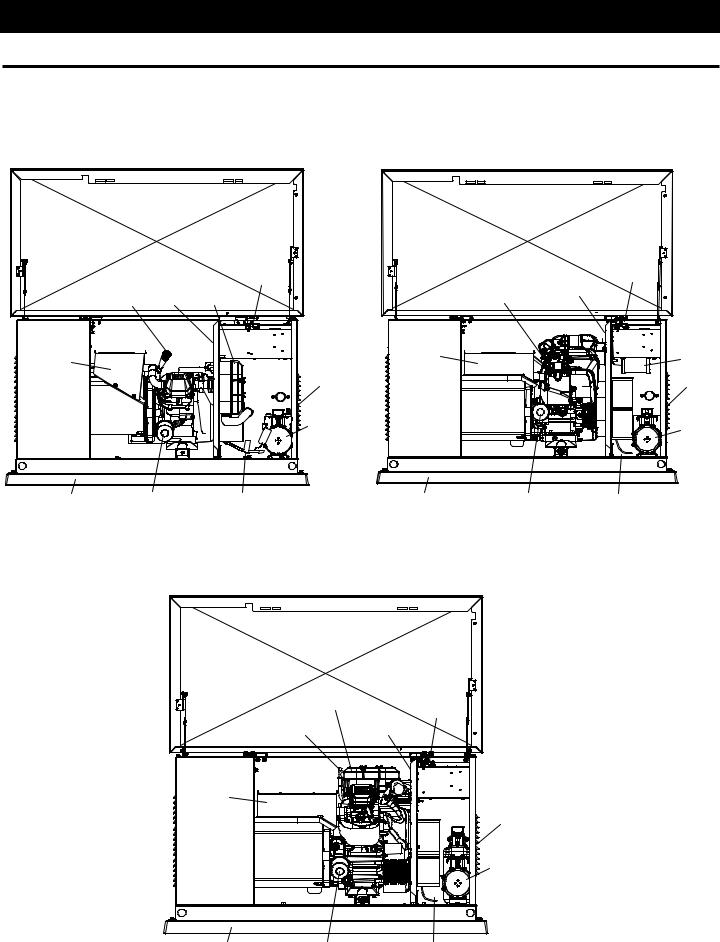
General Information
1.4THE GENERATOR
Figure 1.1 – 7kW, Single Cylinder GH-410 Engine
|
|
Control |
|
|
Panel |
Oil |
Data |
Air Filter |
Dipstick |
Decal |
Cover |
Exhaust |
|
|
Enclosure |
|
|
|
|
Fuel |
|
|
Inlet |
|
|
(Back) |
|
|
Fuel |
|
|
Regulator |
Figure 1.2 – 10kW, V-twin GT-530 Engine |
|
|
|
|
Control |
|
Data |
Panel |
Oil |
|
|
Decal |
|
|
Dipstick |
|
|
|
|
|
Exhaust |
|
|
Enclosure |
|
Air Filter |
|
|
Fuel |
|
|
Inlet |
|
|
(Back) |
|
|
Fuel |
|
|
Regulator |
Composite Base |
Oil Filter |
Battery Compartment |
Composite Base |
Oil Filter |
Battery Compartment |
Figure 1.3 – 13kW and 16kW, V-twin GT-990 Engine
|
Air Filter |
Control |
|
Cover |
|
|
Panel |
|
Oil |
|
|
|
Data |
|
Dipstick |
|
Decal |
Exhaust
Enclosure
Fuel
Inlet (Back)
Fuel
Regulator
Composite Base |
Oil Filter |
Battery Compartment |
5

General Information
1.5SPECIFICATIONS
1.5.1 GENERATOR
Model |
05240 & 05280 |
05241 & 05281 |
05242 & 05282 |
05243 & 05244 |
|
|
|
|
|
|
05283 & 05284 |
Rated Max. Continuous |
6,000 NG/7,000 LP |
9,000 NG/10,000 LP |
13,000 NG/13,000 LP |
15,000 NG/16,000 LP |
|
|
Power Capacity (Watts*) |
|
|
|
|
Rated Voltage |
120/240 |
120/240 |
120/240 |
120/240 |
|
Rated Max. Continuous |
|
|
|
|
|
|
Load Current (Amps) |
|
|
|
|
|
120 Volts** |
50.0 NG/58.3 LP |
75.0 NG/83.3 LP |
108.3 NG/108.3 LP |
125 NG/133.3 LP |
|
240 Volts |
25.0 NG/29.2 LP |
37.5 NG/41.7 LP |
54.1 NG/54.1 LP |
62.5 NG/66.6 LP |
Main Line Circuit Breaker |
30 Amp |
45 Amp |
55 Amp |
65 Amp |
|
Circuits*** |
|
|
|
|
|
|
50A, 240V |
- |
- |
- |
1 |
|
40A, 240V |
- |
- |
1 |
1 |
|
30A, 240V |
1 |
1 |
1 |
- |
|
20A, 240V |
- |
1 |
- |
1 |
|
20A, 120V |
1 |
3 |
3 |
5 |
|
15A, 120V |
5 |
3 |
5 |
5 |
Phase |
1 |
1 |
1 |
1 |
|
Number of Rotor Poles |
2 |
2 |
2 |
2 |
|
Rated AC Frequency |
60 Hz |
60 Hz |
60 Hz |
60 Hz |
|
Power Factor |
1 |
1 |
1 |
1 |
|
Recommended Air Filter |
Part # 0C8127 |
Part # 0E9581 |
Part # 0C8127 |
Part # 0C8127 |
|
Battery Requirement |
Group 26 |
Group 26 |
Group 26 |
Group 26 |
|
|
|
12 Volts and |
12 Volts and |
12 Volts and |
12 Volts and |
|
|
350 Cold-cranking |
525 Cold-cranking |
525 Cold-cranking |
525 Cold-cranking |
|
|
Amperes Minimum |
Amperes Minimum |
Amperes Minimum |
Amperes Minimum |
Battery Warming Blanket |
|
0F6148DSRV |
|
||
Weight (Unit Only) |
336 Pounds |
375 Pounds |
425.5 Pounds |
445 & 414 Pounds |
|
Enclosure |
|
|
|
Steel/Aluminum |
|
Normal Operating Range |
|
-20°F (-28.8°C) to 104°F (40°C) |
|
||
*Maximum wattage and current are subject to and limited by such factors as fuel Btu content, ambient temperature, altitude, engine power and condition, etc. Maximum power decreases about 3.5 percent for each 1,000 feet above sea level; and also will decrease about 1 percent for each 6° C (10° F) above 16° C (60° F) ambient temperature.
**Load current values shown for 120 volts are maximum TOTAL values for two separate circuits. The maximum current in each circuit must not exceed the value stated for 240 volts.
***Circuits to be moved must be protected by same size breaker. For example, a 15 amp circuit in main panel must be a 15 amp circuit in transfer switch.
1.5.2 ENGINE
Model |
|
05240 & 05280 |
|
05241 & 05281 |
|
05242 & 05282 |
|
05243 & 05244 |
|
|
|
|
|||||
|
|
|
|
|
|
|
|
05283 & 05284 |
Type of Engine |
|
GH-410 |
|
GT-530 |
|
GT-990 |
|
GT-990 |
Number of Cylinders |
|
1 |
|
2 |
|
2 |
|
2 |
Rated Horsepower |
|
14.5 @ 3,600 rpm |
|
18 @ 3,600 rpm |
|
30 @ 3,600 rpm |
|
30 @ 3,600 rpm |
Displacement |
|
410cc |
|
530cc |
|
992cc |
|
992cc |
Cylinder Block |
|
Aluminum w/Cast |
|
Aluminum w/Cast |
|
Aluminum w/Cast |
|
Aluminum w/Cast |
|
|
Iron Sleeve |
|
Iron Sleeve |
|
Iron Sleeve |
|
Iron Sleeve |
Valve Arrangement |
|
Overhead Valves |
|
Overhead Valves |
|
Overhead Valves |
|
Overhead Valves |
Ignition System |
|
Solid-state w/Magneto |
|
Solid-state w/Magneto |
|
Solid-state w/Magneto |
|
Solid-state w/Magneto |
Recommended Spark Plug |
|
RC14YC |
|
BPR6HS |
|
RC14YC |
|
RC14YC |
Spark Plug Gap |
|
0.76 mm (0.030 inch) |
|
0.76 mm (0.030 inch) |
|
1.02 mm (0.040 inch) |
|
1.02 mm (0.040 inch) |
Compression Ratio |
|
8.6:1 |
|
9.5:1 |
|
9.5:1 |
|
9.5:1 |
Starter |
|
12 Vdc |
|
12 Vdc |
|
12 Vdc |
|
12 Vdc |
Oil Capacity Including Filter |
|
Approx. 1.5 Qts |
|
Approx. 1.7 Qts |
|
Approx. 1.7 Qts |
|
Approx. 1.7 Qts |
Recommended Oil Filter |
|
Part # 070185F |
|
Part # 070185F |
|
Part # 070185F |
|
Part # 070185F |
Recommended Air Filter |
|
Part # 0C8127 |
|
Part # 0E9581 |
|
Part # 0C8127 |
|
Part # 0C8127 |
Operating RPM |
|
3,600 |
|
3,600 |
|
3,600 |
|
3,600 |
|
|
|
|
|
|
|
|
|
6

General Information
1.6SYSTEM SET LED
The “System Set” LED is lit when all of the following conditions are true:
1.The AUTO/OFF/MANUAL switch is set to the AUTO position.
2.The utility voltage being supplied to the unit is being sensed by the PCB. If the utility sense voltage is not connected to the unit or if it is below approximately 150-160 volts AC, then the system set light will flash rapidly. This indicates that if the AUTO/OFF/ MANUAL switch is placed in the Auto position, the generator will start.
3.No alarms are present, for example, low oil pressure, high temperature, etc.
1.7FUEL REQUIREMENTS
AND RECOMMENDATIONS
With LP gas, use only the vapor withdrawal system. This type of system uses the vapors formed above the liquid fuel in the storage tank.
The engine has been fitted with a fuel carburetion system that meets the specifications of the 1997 California Air Resources Board for tamper-proof dual fuel systems. The unit will run on natural gas or LP gas, but it has been factory set to run on natural gas. Should the primary fuel need to be changed to LP gas, the fuel system needs to be reconfigured. See the Reconfiguring the Fuel System section for instructions on reconfiguration of the fuel system.
Recommended fuels should have a Btu content of at least 1,000 Btus per cubic foot for natural gas; or at least 2,520 Btus per cubic foot for LP gas. Ask the fuel supplier for the Btu content of the fuel.
Required fuel pressure for natural gas is 5 inches to 7 inches water column (0.18 to 0.25 psi); and for liquid propane, 10 inches to 12 inches of water column (0.36 to 0.43 psi).
NOTE:
All pipe sizing, construction and layout must comply with NFPA 54 for natural gas applications and NFPA 58 for liquid propane applications. Once the generator is installed, verify that the fuel pressure NEVER drops below four (4) inches water column for natural gas or 10 inches water column for liquid propane.
Prior to installation of the generator, the installer should consult local fuel suppliers or the fire marshall to check codes and regulations for proper installation. Local codes will mandate correct routing of gaseous fuel line piping around gardens, shrubs and other landscaping to prevent any damage.
Special considerations should be given when installing the unit where local conditions include flooding, tornados, hurricanes, earthquakes and unstable ground for the flexibility and strength of piping and their connections.
Use an approved pipe sealant or joint compound on all threaded fitting.
All installed gaseous fuel piping must be purged and leak tested prior to initial start-up in accordance with local codes, standards and regulations.
1.8FUEL CONSUMPTION
Unit |
Nat. Gas (*) |
LP Vapor (**) |
||
|
|
|
|
|
|
1/2 Load |
Full Load |
1/2 Load |
Full Load |
|
|
|
|
|
6/7 kW |
66 |
119 |
0.82/30 |
1.47/54 |
|
|
|
|
|
9/10 kW |
102 |
156 |
1.25/46 |
1.93/70 |
13/13 kW |
156 |
220 |
1.55/57 |
2.18/80 |
|
|
|
|
|
15/16 kW |
173 |
245 |
1.59/59 |
2.51/92 |
|
|
|
|
|
*Natural gas is in cubic feet per hour.
**LP is in gallons per hour/cubic feet per hour.
*** Values given are approximate.
1.8.1BTU FLOW REQUIREMENTS - NATURAL GAS
BTU flow required for each unit based on 1000 BTU per cubic foot.
•6kW — 119,000 BTU/Hour
•9kW — 156,000 BTU/Hour
•13kW — 220,000 BTU/Hour
•15kW — 245,000 BTU/Hour
Gaseous fuels such as natural gas and liquid propane (LP) gas are highly explosive. Even the slightest spark can ignite such fuels and cause an explosion. No leakage of fuel is permitted. Natural gas, which is lighter than air, tends to collect in high areas. LP gas is heavier than air and tends to settle in low areas.
NOTE:
A minimum of one approved manual shut-off valve must be installed in the gaseous fuel supply line. The valve must be easily accessible. Local codes determine the proper location.
7

General Information
1.9RECONFIGURING THE FUEL SYSTEM
1.9.17 KW, 410CC ENGINE
To reconfigure the fuel system from NG to LP, follow these steps (Figure 1.4):
NOTE:
The primary regulator for the propane supply is NOT INCLUDED with the generator. A fuel pressure of 10 to 12 inches of water column (0.36 to 0.43 psi) to the fuel inlet of the generator MUST BE SUPPLIED.
1.Turn off the main gas supply (if connected).
2.Open the roof and remove the door.
3.Remove the battery (if installed).
4.Disconnect wire #0 and wire #14 from the gas solenoid on top of the demand regulator.
5.Remove the carburetor fuel hose from the outlet port of the demand regulator.
6.Remove the demand regulator by removing the fastener that retains the regulator mounting bracket.
7.Remove the square headed steel pipe plug from outlet port #1 and the brass hose barb fitting from outlet port #2.
8.Refit the brass hose barb fitting to outlet port #1 and the square headed steel pipe plug to outlet port #2.
Figure 1.4 – Demand Regulator
|
|
HOSE & PLUG |
|
|
SWITCHED SIDES |
FUEL HOSE |
|
|
|
PIPE |
FUEL HOSE |
|
|
|
BRASS HOSE |
PLUG |
BRASS HOSE |
|
||
FITTING |
|
FITTING |
|
|
OUTLET |
ADJUSTMENT |
|
PORT |
|
|
|
SCREW |
|
|
|
|
FUEL JET |
NG FUEL SYSTEM |
|
|
|
|
LP FUEL SYSTEM |
|||
|
|
|
|
|
|
|
|
|
|
|
|
|
|
|
|
|
|
|
|
|
|
|
|
|
|
|
|
|
|
|
|
|
|
|
|
|
|
|
|
|
|
|
|
|
STATIC
PRESSURE
TAP
RUNNING
PRESSURE
TAP
NOTE:
Use an approved pipe sealant or joint compound on all threaded fittings to reduce the possibility of leakage.
9.Reverse procedure steps 1-6 to reinstall demand regulator.
10.Take the plastic plug supplied in the poly-bag with the generator and press it into the 3/4” hole on the bottom of the air cleaner base (Figure 4.6).
11.Reverse the procedure to convert back to natural gas.
12.Check for gas leakage at the pipe plug, hose connection and fittings.
1.9.210, 13 AND 16KW, V-TWIN ENGINES
To reconfigure the fuel system from NG to LP, follow these steps:
NOTE:
The primary regulator for the propane supply is NOT INCLUDED with the generator. A fuel pressure of 10 to 12 inches of water column (0.36 to 0.43 psi) to the fuel inlet of the generator MUST BE SUPPLIED.
1.Open the roof.
2.For 10kW units: Loosen clamp and slide back the air inlet hose.
•Slide fuel selector on carburetor out towards the back of the enclosure (Figures 1.5 and 1.6).
•Return the inlet hose and tighten clamp securely.
For 13 and 16kW units: remove the air cleaner cover.
•Slide the selector lever out towards the back of the enclosure (Figures 1.7 and 1.8).
•Return the air cleaner cover and tighten the two thumb screws.
3.Close the roof.
4.Reverse the procedure to convert back to natural gas.
Figure 1.5 - 10kW, GT-530 (Inlet Hose Slid Back)
8

Figure 1.6 - 10kW, GT-530 (Inlet Hose Slid Back)
Fuel Selection
Lever - "Out"
Position for
Liquid Propane
(Vapor) Fuel
Figure 1.7 - 13/16kW, GT-990 (Airbox Cover Removed)
Fuel Selection Lever - "In" Position for Natural Gas Fuel
Figure 1.8 - 13/16kW, GT-990 (Airbox Cover Removed)
Fuel Selection Lever - "Out" Position for Liquid Propane (Vapor) Fuel
General Information
1.10 LOCATION
1.10.1 GENERATOR
nThe engine exhaust fumes contain carbon monoxide, which can be DEADLY. This dangerous gas, if breathed in sufficient concentrations, can cause unconsciousness or even death. This exhaust system must be installed properly, in strict compliance with applicable codes and standards. Following installation, do nothing that might render the system unsafe or in noncompliance with such codes and standards.
•Operate the generator outdoors ONLY.
•Keep exhaust gases from entering a confined area through windows, doors, ventilation or other openings (Figure 1.9).
Install the generator set, in its protective enclosure, outdoors, where adequate cooling and ventilating air is always available (Figure 1.9). Consider these factors:
•The installation of the generator must comply strictly with
NFPA 37, NFPA 54, NFPA 58, and NFPA 70 standards (http:// www.nfpa.org/).
•Install the unit where air inlet and outlet openings will not become obstructed by leaves, grass, snow, etc.. If prevailing winds will cause blowing or drifting, consider using a windbreak to protect the unit.
•Install the generator on high ground where water levels will not rise and endanger it.
•Allow sufficient room on all sides of the generator for maintenance and servicing. This unit must be installed in accordance with current applicable NFPA 37 and NFPA 70 standards; as well as any other federal, state and local codes for minimum distances from other structures. DO NOT install under wooden decks or structures.
•Install the unit where rain gutter down spouts, roof run-off, landscape irrigation, water sprinklers or sump pump discharge does not flood the unit or spray the enclosure, including any air inlet or outlet openings.
Figure 1.9 – Generator Clearances
9

General Information
•Install the unit where services will not be affected or obstructed, including concealed, underground or covered services such as electrical, fuel, phone, air conditioning or irrigation.
•Where strong prevailing winds blow from one direction, face the generator air inlet openings to the prevailing winds.
•Install the generator as close as possible to the fuel supply, to reduce the length of piping.
•Install the generator as close as possible to the transfer switch. REMEMBER THAT LAWS OR CODES MAY REGULATE THE DISTANCE AND LOCATION.
•The genset must be installed on a level surface. The base frame must be level within two (2) inches all around.
1.10.2 TRANSFER SWITCH
1.10.2.1 7, 10, 13, and 16 kW Units (if equipped)
The transfer switch shipped with this generator is enclosed in a NEMA 1 enclosure. This type of enclosure is intended for indoor use only. Follow these rules:
•Install the transfer switch indoors on a firm, sturdy supporting structure.
•To prevent switch distortion, level the switch if necessary. This can be done by placing washers between the switch enclosure and mounting surface.
•Never install the switch where water or any corrosive substance might drip onto the enclosure.
•Protect the switch at all times against excessive moisture, dust, dirt, lint, construction grit and corrosive vapors.
If the AUTO/OFF/MANUAL switch is not set to its OFF position, the generator can crank and start as soon as the battery cables are connected. If the utility power supply is not turned off, sparking can occur at the battery posts and cause an explosion.
1.11 BATTERY REQUIREMENTS
See the Specifications section for correct battery size and rating.
1.12 BATTERY INSTALLATION
Fill the battery with the proper electrolyte fluid if necessary and have the battery fully charged before installing it.
Before installing and connecting the battery, complete the following steps:
1.Set the generator's AUTO/OFF/MANUAL switch to OFF.
2.Turn off utility power supply to the transfer switch.
3.Remove the 15A fuse from the generator control panel.
Battery cables were factory connected at the generator (Figure 1.10). Connect cables to battery posts as follows:
4.Connect the red battery cable (from starter contactor) to the battery post indicated by a positive, POS or (+).
5.Connect the black battery cable (from frame ground) to the battery post indicated by a negative, NEG or (—).
NOTE:
Dielectric grease should be used on battery posts to aid in the prevention of corrosion.
NOTE:
Damage will result if battery connections are made in reverse.
Figure 1.10 – Battery Cable Connections
NOTE:
In areas where temperatures regularly fall below 10° F (-12° C) it is recommended that a pad type battery heater be installed to aid in cold climate starting (see Specifications).
NOTE:
The generator is equipped with a battery trickle charger that is active when the unit is set up for automatic operation. With the battery installed and utility power source voltage available to the transfer switch, the battery receives a trickle charge while the engine is not running, to prevent self-discharge. The trickle charger is designed to help extend the life of the battery by maintaining the battery when the unit is not running. The trickle charge feature cannot be used to recharge a discharged battery.
10

Post Installation Start-up and Adjustments
1.13 THE BATTERY
Do not dispose of the battery in a fire. The battery is capable of exploding.
A battery presents a risk of electrical shock and high short circuit current. The following precautions are to be observed when working on batteries:
•Remove the 15A fuse from the generator control panel.
•Remove watches, rings or other metal objects;
•Use tools with insulated handles;
•Wear rubber gloves and boots;
•Do not lay tools or metal parts on top of the battery; and
•Disconnect charging source prior to connecting or disconnecting battery terminals.
nDo not open or mutilate the battery.
Released electrolyte has been known to be harmful to the skin and eyes, and to be toxic.
nThe electrolyte is a dilute sulfuric acid that is harmful to the skin and eyes. It is electrically conductive and corrosive.
The following procedures are to be observed:
•Wear full eye protection and protective clothing;
•Where electrolyte contacts the skin, wash it off immediately with water;
•Where electrolyte contacts the eyes, flush thoroughly and immediately with water and seek medical attention; and
•Spilled electrolyte is to be washed down with an acid neutralizing agent. A common practice is to use a solution of 1 pound (500 grams) bicarbonate of soda to 1 gallon (4 liters) of water. The bicarbonate of soda solution is to be added until the evidence of reaction (foaming) has ceased. The resulting liquid is to be flushed with water and the area dried.
Lead-acid batteries present a risk of fire because they generate hydrogen gas. The following procedures are to be followed:
•DO NOT SMOKE when near the battery;
•DO NOT cause flame or spark in battery area; and
•Discharge static electricity from body before touching the battery by first touching a grounded metal surface.
nBe sure the AUTO/OFF/MANUAL switch is set to the OFF position before connecting the battery cables. If the switch is set to AUTO or MANUAL, the generator can crank and start as soon as the battery cables are connected.
Be sure the utility power supply is turned off and the 15A fuse is removed from the generator control panel, or sparking may occur at the battery posts as the cables are attached and cause an explosion.
Servicing of the battery is to be performed or supervised by personnel knowledgeable of batteries and the required precautions. Keep unauthorized personnel away from batteries.
See the Specifications section for the correct size and rating when replacing the battery. When using a maintenance-free battery, it is not necessary to check the specific gravity or electrolyte level. Have these procedures performed at the intervals specified in the “Service Schedule.” A negative ground system is used. Battery connections are shown on the wiring diagrams. Make sure the battery is correctly connected and terminals are tight. Observe battery polarity when connecting the battery to the generator set.
2.1BEFORE INITIAL START-UP
NOTE:
These units have been run and tested at the factory prior to being shipped and do not require any type of break-in.
Before starting, complete the following:
1.Set the generator’s main circuit breaker to its OFF (or OPEN) position.
2.Set the generator's AUTO/OFF/MANUAL switch to the OFF position.
3.Turn OFF all breakers on the load center of the transfer box (T1 and T2).
4.Turn OFF all loads connected to the transfer switch terminals T1 and T2.
5.Check the engine crankcase oil level and, if necessary, fill to the dipstick FULL mark with the recommended oil. Do not fill above the FULL mark.
6.Check the fuel supply. Gaseous fuel lines must have been properly purged and leak tested in accordance with applicable fuel-gas codes. All fuel shutoff valves in the fuel supply lines must be open.
During initial start up, after installation, it is normal for the generator to exceed the normal number of start attempts and experience an “over crank” fault. This is due to accumulated air in the fuel system during shipment.
NOTE:
This procedure applies to 13kW and 16kW units only and should be performed by trained personnel.
nNever operate the engine with the oil level below the “Add” mark on the dipstick. Doing this could damage the engine.
11

Post Installation Start-up and Adjustments
2.2CHECK TRANSFER SWITCH
OPERATION
Refer to the "Manual Transfer Operation" section, of the owner’s manual for procedures.
Do not attempt manual transfer switch operation until all power voltage supplies to the transfer switch have been positively turned off. Failure to turn off all power voltage supplies will result in extremely hazardous and possibly fatal electrical shock.
2.3ELECTRICAL CHECKS
Complete electrical checks as follows:
1.Set the generator's main circuit breaker to its OFF (or OPEN) position.
2.Set the generator's AUTO/OFF/MANUAL switch to the OFF position.
3.Turn OFF all breakers on the load center of the transfer box (T1 and T2).
4.Turn on the utility power supply to the transfer switch using the means provided (such as a utility main line circuit breaker).
The transfer switch is now electrically
“hot.” Contact with “hot” parts will result in extremely hazardous and possibly fatal electrical shock. Proceed with caution.
5.Use an accurate AC voltmeter to check utility power source voltage across transfer switch terminals N1 and N2. Nominal line-to-line voltage should be 240 volts AC.
6.Check utility power source voltage across terminals N1 and the transfer switch neutral lug; then across terminal N2 and neutral. Nominal line-to-neutral voltage should be 120 volts AC.
7.When certain that utility supply voltage is compatible with transfer switch and load circuit ratings, turn OFF the utility power supply to the transfer switch.
8.On the generator panel, set the AUTO/OFF/ MANUAL switch to MANUAL. The engine should crank and start.
9.Let the engine warm up for about five minutes to allow internal temperatures to stabilize. Then, set the generator’s main circuit breaker to its ON (or CLOSED) position.
Proceed with caution! Generator power voltage is now supplied to the transfer switch. Contact with live transfer switch parts will result in dangerous and possibly fatal electrical shock.
10.Connect an accurate AC voltmeter and a frequency meter across transfer switch terminal lugs E1 and E2. 7kW voltage should be 242-252 volts at a frequency of 61-63 Hertz. 10, 13, and 16kW voltage should be 247-249 volts at a frequency of 57.5-59.5 Hertz.
11.Connect the AC voltmeter test leads across terminal lugs E1 and neutral; then across E2 and neutral. In both cases, voltage reading should be 121-126 volts AC (7kW), and 125-126 volts AC (10, 13 and 16kW).
12.Set the generator’s main circuit breaker to its OFF (or OPEN) position. Let the engine run at no-load for a few minutes to stabilize internal engine generator temperatures.
13.Set the generator's AUTO/OFF/MANUAL switch to OFF. The engine should shut down.
NOTE:
It is important not to proceed until certain that generator AC voltage and frequency are correct and within the stated limits. Generally, if both AC frequency and voltage are high or low, the engine governor requires adjustment* (*GH410 only). If frequency is correct, but voltage is high or low, the generator’s voltage regulator requires adjustment.
2.4GENERATOR TESTS UNDER
LOAD
To test the generator set with electrical loads applied, proceed as follows:
1.Set generator’s main circuit breaker to its OFF (or OPEN) position.
2.Turn OFF all breakers on the load center of the transfer box (T1 and T2).
3.Set the generator's AUTO/OFF/MANUAL switch to OFF.
4.Turn OFF the utility power supply to the transfer switch, using the means provided (such as a utility main line circuit breaker).
Do not attempt manual transfer switch operation until all power voltage supplies to the transfer switch have been positively turned off. Failure to turn off all power voltage supplies will result in extremely hazardous and possibly fatal electrical shock.
5.Manually set the transfer switch to the STANDBY position, i.e., load terminals connected to the generator's E1/E2 terminals. The transfer switch operating lever should be down.
6.Set the generator's AUTO/OFF/MANUAL switch to MANUAL. The engine should crank and start immediately.
7.Let the engine stabilize and warm up for a few minutes.
8.Set the generator’s main circuit breaker to its ON (or closed) position. Loads are now powered by the standby generator.
9.Turn ON the load center of the transfer switch (T1 and T2).
12

Post Installation Start-up and Adjustments
10.Connect an accurate AC voltmeter and a frequency meter across terminal lugs E1 and E2.
•7kW voltage should be greater than 230 volts and frequency should be greater than 58 Hz.
•10, 13 & 16kW voltage should be greater than 240 volts and frequency should be greater than 60 Hz.
11.Let the generator run at full rated load for 20-30 minutes. Listen for unusual noises, vibration or other indications of abnormal operation. Check for oil leaks, evidence of overheating, etc.
12.When testing under load is complete, turn OFF electrical loads.
13.Set the generator's main circuit breaker to its OFF (or OPEN) position.
14.Let the engine run at no-load for a few minutes.
15.Set the AUTO/OFF/MANUAL switch to OFF. The engine should shut down.
2.5CHECKING AUTOMATIC
OPERATION
To check the system for proper automatic operation, proceed as follows:
1.Set generator’s main circuit breaker to its OFF (or OPEN) position.
2.Check that the AUTO/OFF/MANUAL switch is set to OFF.
3.Turn OFF the utility power supply to the transfer switch, using means provided (such as a utility main line circuit breaker).
4.Manually set the transfer switch to the UTILITY position, i.e., load terminals connected to the utility power source side.
5.Turn ON the utility power supply to the transfer switch, using the means provided (such as a utility main line circuit breaker).
6.Set the generator's main circuit breaker to its ON (or CLOSED)) position.
7.Set the AUTO/OFF/MANUAL switch to AUTO. The system is now ready for automatic operation.
8.Turn OFF the utility power supply to the transfer switch.
With the AUTO/OFF/MANUAL switch at AUTO, the engine should crank and start when the utility source power is turned OFF after a 10 second delay. After starting, the transfer switch should connect load circuits to the standby side after a 15 second delay. Let the system go through its entire automatic sequence of operation.
With the generator running and loads powered by generator AC output, turn ON the utility power supply to the transfer switch. The following should occur:
•After about 15 seconds, the switch should transfer loads back to the utility power source.
•About one minute after retransfer, the engine should shut down.
2.6ADJUSTING THE FUEL REGULATOR - 7KW (NATURAL
GAS ONLY)
NOTE:
All V-twin engine units DO NOT require a fuel regulator adjustment due to the fuel system design.
Although the generator has been factory set to provide maximum power, it may be necessary in some areas to adjust this setting. If experiencing engine problems at high or full load conditions, follow these steps. It will require a frequency meter to perform this procedure.
1.Turn off utility power to the main distribution panel in the house. This can be done by switching the service main breaker to the off or open position.
2.Allow the generator to start. Before loading the generator, confirm that the No Load Frequency, with the roof open and door off, is set to 63-63.5 Hz. Transfer load to emergency circuits.
3.Turn on appliances, lights, pumps, etc., that are on the emergency circuits in an attempt to fully load the generator. Be cautious not to overload the generator. Use the following chart as a guide:
4.When 3/4 load has been achieved. Connect a frequency meter to the output lugs of the generator’s main line circuit breaker.
5.The fuel regulator is fitted with one adjustment screw. While watching the frequency meter, slowly turn the adjustment screw clockwise or counterclockwise until the highest frequency is read on the meter. Only limited adjustment is available because of the set pin. Under no circumstances should any of the pins be removed (Figure 2.3).
Figure 2.3 — 7kW Fuel Regulator
ngine |
410cc Engine |
Adjustment |
Set |
Screw |
|
(One Side |
Pin |
Only) |
|
6.When the highest frequency is reached maximum power has been set. From this point turn the adjustment screw 1/4 turn counterclockwise. The regulator is now set.
7.Turn utility power to the main distribution panel back on. This can be done by switching the service main breaker to the on or closed position. Allow the generator to shut down.
13
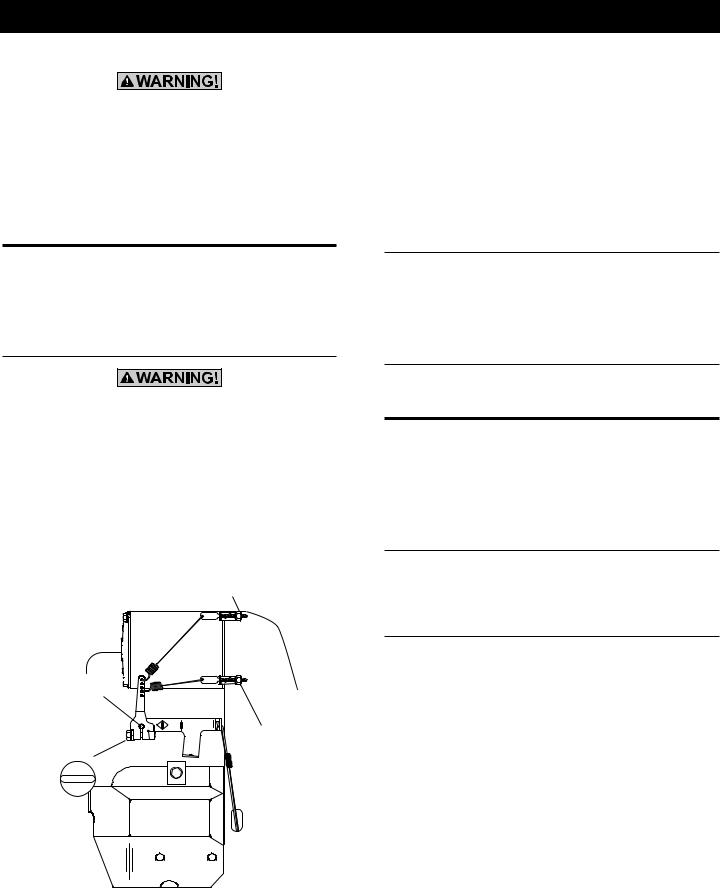
Post Installation Start-up and Adjustments
nDo not make any unnecessary adjustments.
Factory settings are correct for most applications. However, when making adjustments, be careful to avoid overspeeding the engine.
If this procedure or the test equipment is not available, locate the nearest Dealer and they can perform the adjustments.
NOTE:
A service fee may be charged for this adjustment.
3.Start the generator; let it stabilize and warm up at no-load.
4.Connect a frequency meter across the generators AC output leads.
5.Turn the primary adjust screw to obtain a frequency reading of 61.5 Hertz. Turn the secondary adjust screw to obtain a frequency of 62.5 Hz.
6.When frequency is correct at no load, check the AC voltage reading. If voltage is incorrect, the voltage regulator may require adjustment (See the Voltage Regulator Adjustment section).
2.7ENGINE GOVERNOR
ADJUSTMENT
If both AC frequency and voltage are correspondingly high or low, adjust the engine governor as follows:
2.7.17 KW UNITS
nThe engine must be OFF to perform steps 1 and 2.
1.Loosen the governor clamp bolt (Figure 2.4).
2.Hold the governor lever at its wide open throttle position (clockwise), and rotate the governor shaft clockwise as far as it will go. Then, tighten the governor lever clamp bolt to 70 inch-pounds (8 N-m).
Figure 2.4 — Engine Governor Adjustment Single
Cylinder Engines
SECONDARY
ADJUST SCREW
2.7.213 KW AND 16 KW UNITS
NOTE:
All V-twin units DO NOT require an engine governor adjustment due to their design.
2.7.3ADDITIONAL CORROSION PROTECTION
Periodically spray all engine linkage parts and brackets with corrosion inhibiting spray such as WD-40 or a comparable product.
2.8VOLTAGE REGULATOR ADJUSTMENT
|
Unit |
120 Volts |
240 Volts |
|
|
7 kW |
50.0 amps |
25.0 amps |
|
|
|
|
|
|
2.8.17KW UNITS
With the frequency between 62-63 Hertz at no-load, slowly turn the slotted potentiometer (Figure 2.5) until line voltage reads 248252 volts.
GOVERNOR 


SHAFT
GOVERNOR |
PRIMARY |
|
CLAMP |
||
ADJUST |
||
BOLT |
||
SCREW |
||
|
2.8.210, 13, AND 16KW UNITS
With the frequency between 58-59 Hertz at no-load, slowly turn the slotted potentiometer (Figure 2.3) until line voltage reads 247249 volts.
NOTE:
The access panel on top of the control panel must be removed to adjust the voltage regulator.
NOTE:
The voltage regulator is housed above the generator's control panel. The regulator maintains a voltage in direct proportion to frequency at a 2-to-1 ratio. For example, at 62 Hertz, line-to- neutral voltage will be 124 volts.
14
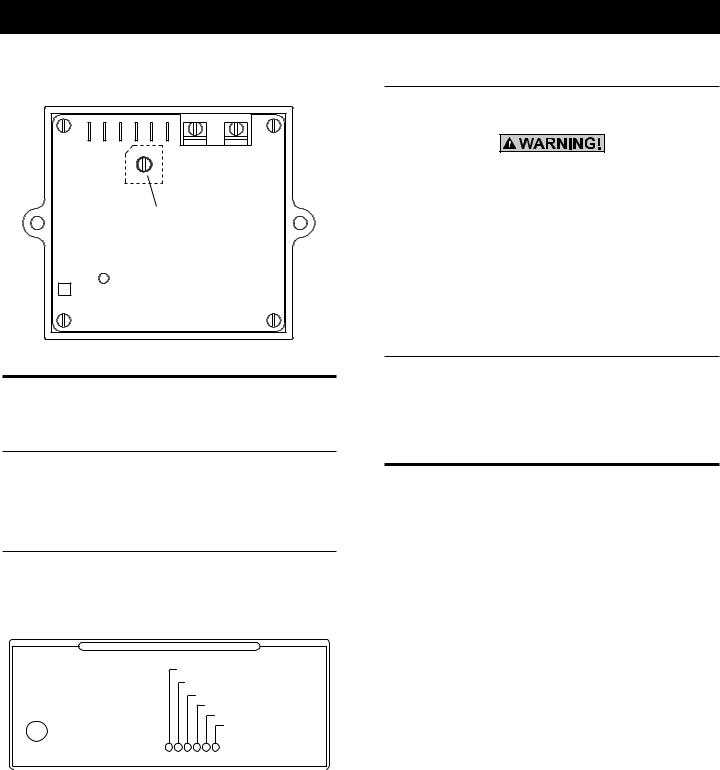
Figure 2.5 – Voltage Adjustment Potentiometer
Turn to |
adjust voltage. |
3.1USING THE AUTO/OFF/ MANUAL SWITCH (FIGURE 3.1)
3.1.1“AUTO” POSITION
Selecting this switch position activates fully automatic system operation. It also allows the unit to automatically start and exercise the engine every seven days with the setting of the exercise timer (see the Setting the Exercise Timer section).
3.1.2“OFF” POSITION
This switch position shuts down the engine. This position also prevents automatic operation.
Figure 3.1 – Generator Control Panel
CONTROL AND INFORMATION CENTER
|
|
|
|
SYSTEM SET |
||||
|
|
|
|
LOW BATTERY |
||||
|
|
|
|
LOW OIL |
||||
AUTO. OFF |
MAN. |
|||||||
HIGH TEMP |
||||||||
|
|
|
|
|||||
SYSTEM FUSE |
|
|
|
|
|
OVER SPEED |
||
|
|
|
|
|
|
|
NO RPM SENSE IF FLASHING |
|
|
|
|
|
|
|
|
OVER CRANK |
|
|
|
|
|
|
|
|
FLASHING GREEN LED= |
|
15A |
SET |
|
|
|
||||
|
|
|
NO UTILITY SENSE |
|||||
ASSY: 0F8418/0F8419 |
EXERCISE |
|
|
|
5 FLASHING RED LEDS= |
|||
TIME |
|
|
|
EXERCISER NOT SET |
||||
|
|
|
|
|
||||
|
|
|
|
|
|
|
|
|
Operation
3.1.3“MANUAL” POSITION
Set the switch to MANUAL to crank and start the engine. Transfer to standby power will not occur unless there is a utility failure.
nWith the switch set to AUTO, the engine may crank and start at any time without warning. Such automatic starting normally occurs when utility power source voltage drops below a preset level or during the normal exercise cycle. To prevent possible injury that might be caused by such sudden starts, always set the switch to OFF and remove the fuses before working on or around the generator or transfer switch. Then, place a “DO NOT OPERATE” tag on the generator panel and on the transfer switch.
3.1.4CHOKE OPERATION
1.990 engines have an electric choke in the air box that is automatically controlled by the electronic control board.
2.530 engines have an electric choke on the divider panel air inlet hose that is automatically controlled by the electronic control board.
3.410 engines do not have a choke.
3.2AUTOMATIC TRANSFER
OPERATION
To select automatic operation, do the following:
1.Make sure the transfer switch main contacts are set to their UTILITY position, i.e., loads connected to the utility power source (Figure 3.2).
2.Be sure that normal UTILITY power source voltage is available to transfer switch terminal lugs N1 and N2 (Refer to the Electrical Data section).
3.Set the generator’s AUTO/OFF/MANUAL switch to AUTO.
4.Set the generator’s main circuit breaker to its ON (or CLOSED) position.
With the preceding steps complete, the generator will start automatically when utility source voltage drops below a preset level. After the unit starts, loads are transferred to the standby power source. Refer to the Sequence of Automatic Operation section.
15

Operation
3.3SEQUENCE OF AUTOMATIC
OPERATION
The generator’s control panel houses a control logic circuit board. This board constantly monitors utility power source voltage. Should that voltage drop below a preset level, circuit board action will signal the engine to crank and start. After the engine starts, the circuit board signals the transfer switch to activate and connect load circuits to the standby power supply (load terminal lugs T1/T2 connect to terminal lugs E1/E2). Refer to the Electrical Data section.
The generator must run at 50 Hz or greater for the transfer output to be activated. Once activated, it will remain active even if the frequency dips below 50 Hz.
Upon restoration of utility source voltage above a preset level, generator circuit board action signals the transfer switch to transfer loads back to that power supply. After retransfer, the engine is signalled to shut down.
The actual sequence of operation is controlled by sensors and timers on a control logic circuit board, as follows:
A.Utility Voltage Dropout Sensor
•This sensor monitors utility source voltage.
•If utility source voltage drops below about 65 percent of the nominal supply voltage, the sensor energizes a 10 second timer.
•Once the timer has expired, the engine will crank and start if utility is still low.
B.Engine Warm-up Time Delay
•This mechanism lets the engine warm up for about five
(5)seconds before the load is transferred to the standby source.
C.Standby Voltage Sensor
•This sensor monitors generator AC output voltage. When the voltage has reached 50 percent of the nominal rated voltage, transfer to standby can occur.
D.Utility Voltage Pickup Sensor
•This sensor monitors utility power supply voltage. When that voltage is restored above 75 percent of the nominal source voltage, a retransfer time delay starts timing.
E.Retransfer Time Delay
•This timer runs for about 15 seconds.
•At end of a 15-second delay, circuit board action de-energizes transfer relay in the transfer switch if utility is still present.
•Retransfer to utility power source then occurs.
F.Engine Cool-down Timer
•When the load is transferred back to utility power source, the engine cool-down timer starts timing.
•The timer will run for about one minute, and the generator will then shut down.
3.4MANUAL TRANSFER OPERATION
3.4.1TRANSFER TO GENERATOR POWER SOURCE
To start the generator and activate the transfer switch manually, proceed as follows:
1.Set the generator’s AUTO/OFF/MANUAL switch to OFF.
2.Set the generator’s main circuit breaker to its OFF (or OPEN) position.
3.Turn OFF the utility power supply to the transfer switch using the means provided (such as a utility main line circuit breaker).
Do not attempt to activate the transfer switch manually until all power voltage supplies to the switch have been positively turned off. Failure to turn off all power voltage supplies may result in extremely hazardous and possibly fatal electrical shock.
4.Use the manual transfer handle inside the transfer switch to move the main contacts to their STANDBY position, i.e., loads connected to the standby power source (Figure 3.2).
5.To crank and start the engine, set the AUTO/OFF/MANUAL switch to MANUAL.
6.Let the engine stabilize and warm up for a few minutes.
7.Set the generator’s main circuit breaker to its ON (or CLOSED) position. The standby power source now powers the loads.
Figure 3.2 – Manual Transfer Switch Operation
16

3.4.2TRANSFER BACK TO UTILITY POWER SOURCE
When utility power has been restored, transfer back to that source and shut down the generator. This can be accomplished as follows:
1.Set the generator’s main circuit breaker to its OFF (or OPEN) position.
2.Let the engine run for a minute or two at no-load to stabilize the internal temperatures.
3. Set the generator’s AUTO/OFF/MANUAL switch to its OFF (or OPEN) position. The engine should shut down.
4.Check that utility power supply to the transfer switch is turned OFF.
Do not attempt to activate the transfer switch manually until all power voltage supplies
to the switch have been positively turned off. Failure to turn off all power voltage supplies may result in extremely hazardous and possibly fatal electrical shock.
5.Use the manual transfer handle inside the transfer switch to move the main contacts back to their UTILITY position, i.e., loads connected to the utility power source (Figure 3.2).
6.Turn ON the utility power supply to the transfer switch using the means provided.
7.Set the system to automatic operation as outlined in Automatic Transfer Operation section.
3.5SETTING THE EXERCISE TIMER
This generator is equipped with an exercise timer. Once it is set, the generator will start and exercise once every seven days, on the day of the week and at the time of day the following sequence is completed. During this exercise period, the unit runs for approximately 12 minutes and then shuts down. Transfer of loads to the generator output does not occur during the exercise cycle unless utility power is lost.
A switch on the control panel (see Figure 3.1) permits selection of the day and time for the system to exercise. At the chosen time, perform the following sequence to select the desired day and time of day the system will exercise. Remember seasonal time changes affect the exercise time settings.
1.Verify that the AUTO/OFF/MANUAL switch is set to AUTO.
2.Press and hold the "Set Exercise Time" switch for several seconds, then release. All the red LED's will flash for approximately 10 seconds and then stop.
3.Once the red LED's stop flashing, the generator will start and run for approximately 12 minutes and then shut down. The exerciser is now set to run at this time of day each week.
Example: If the "Set Exercise Time" switch is pressed on Saturday afternoon at 2:00 p.m., the generator will start and exercise for approximately 12 minutes every Saturday at 2:00 p.m..
Operation
NOTE:
The exerciser will only work in the AUTO mode and will not work unless this procedure is performed. The exerciser will need to be reset every time the 12-volt battery is disconnected and then reconnected, and when the 15A fuse is removed.
The 16kW unit has a low speed exercise option. Dip switch 1 on the control board is factory set to OFF. This allows the engine to run at a slower speed during weekly exercise periods for quieter operation. If this Dip switch is set to ON, the generator will exercise at it's normal speed.
This DIP switch position is only read at board power up. If the DIP switch position is changed, power to the board must be cycled for the micro controller to recognize the new DIP switch position.
Low speed exercise will be handled as follows:
1.The standard start sequence will be initiated.
2.The unit will run at 2,400 RPM.
3.If utility is lost during exercise, the controller will do the following:
•Wait 10 seconds for utility to return.
•If utility returns within 10 seconds, continue to exercise at 2,400 RPM.
•If utility is still lost after 10 seconds, run the engine up to 3600 RPM and transfer the load. At this time the controller will exit the exercise routine and assume full automatic operation.
3.6PROTECTION SYSTEMS
3.6.1LOW OIL PRESSURE SWITCH
This switch (Figure 3.3) has normally closed contacts that are held open by engine oil pressure during cranking and operating. Should oil pressure drop below the 8 psi range, switch contacts close, and the engine shuts down. The unit should not be restarted until oil is added. The AUTO/OFF/MANUAL switch must then be turned to OFF and then back to AUTO.
3.6.2HIGH TEMPERATURE SWITCH
This switch’s contacts (Figure 3.3) close if the temperature should exceed approximately 144º C (293º F), initiating an engine shutdown. The generator will automatically restart and the LED on the generator control panel will reset once the temperature has returned to a safe operating level.
17
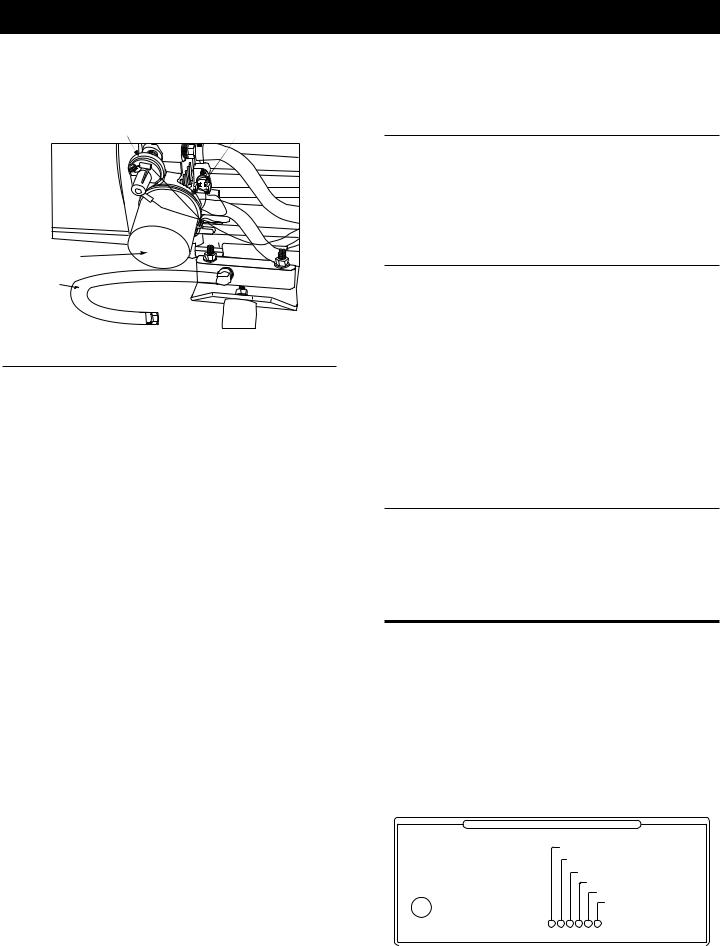
Maintenance
Figure 3.3 – Low Oil Pressure and
High Temperature Switches
Low Oil Switch |
High Temp Switch |
 Loosen
Loosen
Oil Filter
Oil
Drain
Hose
3.6.3OVERCRANK
This feature prevents the generator from damaging itself when it continually attempts to start and another problem, such as no fuel supply, prevents it from starting. The unit will crank and rest for a preset time limit. Then, it will stop cranking, and the LED on the generator control panel will light indicating an overcrank failure. The AUTO/OFF/MANUAL switch will need to be set to OFF and then back to AUTO to reset the generator control board.
NOTE:
If the fault is not repaired, the overcrank feature will continue to activate.
3.7.3.1 Approximate Crank Cycle Times
7kW Units:
•15 seconds ON
•7 seconds OFF
•7 seconds ON
•7 seconds OFF
•7 seconds ON
•7 seconds OFF
•7 seconds ON
•7 seconds OFF
•7 seconds ON
•7 seconds OFF
•7 seconds ON
If the unit fails to start, the overcrank alarm LED will be illuminated.
10kW, 13kW and 16kW Units:
•16 seconds ON
•7 seconds OFF
•16 seconds ON
•7 seconds OFF
•7 seconds ON
•7 seconds OFF
•7 seconds ON
•7 seconds OFF
•7 seconds ON
•7 seconds OFF
If the unit fails to start, the overcrank alarm LED will be illuminated.
3.6.4OVERSPEED
This feature protects the generator from damage by shutting it down if it happens to run faster than the preset limit. This protection also prevents the generator from supplying an output that could potentially damage appliances connected to the generator circuit. Contact the nearest Authorized Dealer if this failure occurs.
3.6.5RPM SENSOR FAILURE
During cranking, if the board does not see a valid RPM signal within three (3) seconds, it will shut down and latch out on RPM sensor loss.
During running, if the RPM signal is lost for one full second the board will shut down the engine, wait 15 seconds, then re-crank the engine.
•If an RPM signal is not detected within the first three (3) seconds of cranking, the control board will shut the engine down and latch out on RPM sensor loss.
•If the RPM signal is detected the engine will start and run normally. If the RPM signal is subsequently lost again, the control board will try one more re-crank attempt before latching out and flashing the overspeed LED.
3.6.6LOW BATTERY
The microprocessor will continually monitor the battery voltage and turn on the Low Battery LED if the battery voltage falls below 11.0 volts for one (1) minute. No other action is taken on a low battery condition. Low battery voltage is a non-latching alarm which will automatically clear if the battery voltage rises above 11.0 volts. Battery voltage is NOT monitored during the crank cycle.
4.1FUSES
The 15-amp fuse on the generator panel protects the DC control circuit against overload (Figure 4.1). This fuse is wired in series with the battery output lead to the panel. If this fuse element has melted open, the engine will not be able to crank or start. Replace this fuse using only an identical 15-amp replacement fuse. To replace the fuse, push the fuse holder cap down and rotate it counterclockwise. Whenever the fuse is removed or replaced, the exercise timer needs to be reset.
Figure 4.1 – Generator Control Panel
CONTROL AND INFORMATION CENTER
|
|
|
|
SYSTEM SET |
||||
|
|
|
|
LOW BATTERY |
||||
|
|
|
|
LOW OIL |
||||
AUTO. OFF |
MAN. |
|||||||
HIGH TEMP |
||||||||
|
|
|
|
|||||
SYSTEM FUSE |
|
|
|
|
|
OVER SPEED |
||
|
|
|
|
|
|
|
NO RPM SENSE IF FLASHING |
|
|
|
|
|
|
|
|
OVER CRANK |
|
|
|
|
|
|
|
|
FLASHING GREEN LED= |
|
15A |
SET |
|
|
|
||||
|
|
|
NO UTILITY SENSE |
|||||
ASSY: 0F8418/0F8419 |
EXERCISE |
|
|
|
5 FLASHING RED LEDS= |
|||
TIME |
|
|
|
EXERCISER NOT SET |
||||
|
|
|
|
|
||||
|
|
|
|
|
|
|
|
|
18
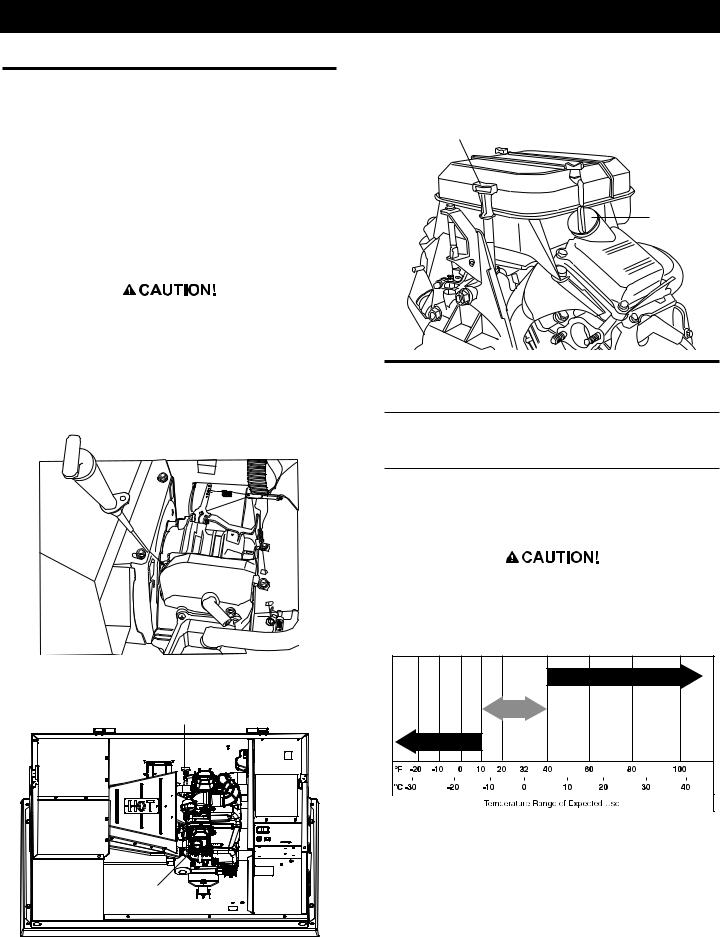
4.2CHECKING THE ENGINE
OIL LEVEL
For oil capacities, see the Specifications section. For engine oil recommendations, see the Engine Oil Recommendations section. To check the engine oil level, proceed as follows (Figures 4.2, 4.3 and 4.4):
1.Move the AUTO/OFF/ MANUAL switch to the OFF position.
2.Remove the dipstick and wipe it dry with a clean cloth.
3.Completely insert the dipstick; then, remove it again. The oil level should be at the dipstick “Full” mark. If necessary, add oil to the “Full” mark only. DO NOT FILL ABOVE THE “FULL” MARK.
nNever operate the engine with the oil level below the “Add” mark on the dipstick. Doing this could damage the engine.
4.Install the dipstick.
5.Reset the AUTO/OFF/MANUAL switch to its original position.
Figure 4.2 — Oil Dipstick and Fill, 7kW
 Oil Dipstick and Fill
Oil Dipstick and Fill
Figure 4.3 — Oil Dipstick and Fill, 10kW
Oil Dipstick
Oil Fill
Maintenance
Figure 4.4 — Oil Dipstick and Fill,
13kW and 16kW
Oil Dipstick
Oil Fill
4.3CHANGING THE ENGINE OIL
4.3.1OIL CHANGE INTERVALS
See the "Service Schedule" section.
4.3.2ENGINE OIL RECOMMENDATIONS
All oil should meet minimum American Petroleum Institute (API) Service Class SJ, SL or better. Use no special additives. Select the oil's viscosity grade according to the expected operating temperature.
nAny attempt to crank or start the engine before it has been properly serviced with the recommended oil may result in an engine failure.
SAE 30 |
10W-30 |
Synthetic 5W-30 |
19
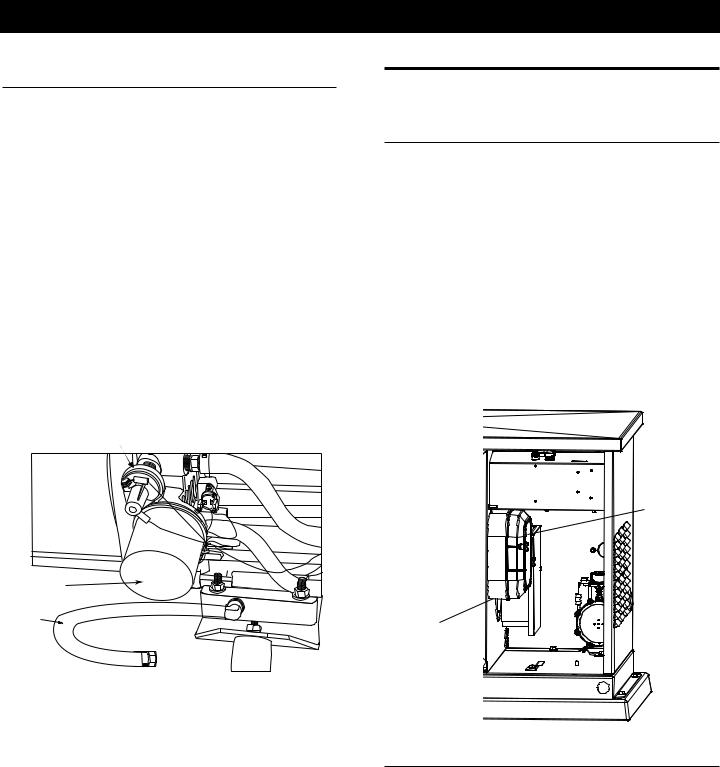
Maintenance
4.3.3OIL & OIL FILTER CHANGE PROCEDURE
To change the oil, proceed as follows:
1.Start the engine by moving the AUTO/OFF/MANUAL switch to MANUAL and run until it is thoroughly warmed up. Then shut OFF the engine by moving the switch to the OFF position.
2.Immediately after the engine shuts OFF, pull the oil drain hose (Figure 4.5) free of its retaining clip. Remove the cap from the hose and drain the oil into a suitable container.
3.After the oil has drained, replace the cap onto the end of the oil drain hose. Retain the hose in the clip.
Change the engine oil filter as follows:
1.With the oil drained, remove the old oil filter by turning it counterclockwise.
2.Apply a light coating of clean engine oil to the gasket of the new filter. See the Specifications section for recommended filter.
3.Screw the new filter on by hand until its gasket lightly contacts the oil filter adapter. Then, tighten the filter an additional 3/4 to one turn (Figure 4.4).
Figure 4.5 – Oil Drain Hose and Filter
Low Oil Switch |
High Temp Switch |
 Loosen
Loosen
Oil Filter
Oil
Drain
Hose
4.Refill with the proper recommended oil (see the Engine Oil Recommendations section). See the Specifications section for oil capacities.
5.Start the engine, run for one (1) minute, and check for leaks.
6.Shutdown and recheck oil level, add as needed. DO NOT OVER FILL.
7.Reset the AUTO/OFF/MANUAL switch to the AUTO position.
4.4CHANGING THE ENGINE AIR CLEANER
4.4.17, 13, AND 16KW GENERATORS
See Figures 1.1 and 1.2, for the location of the air cleaner. Use the following procedures (Figure 4.6, 7kW; Figure 4.8, 13/16kW):
1.Lift the roof and remove the door.
2.Turn the two screws counterclockwise to loosen.
3.Remove the cover and air filter.
4.Wipe away dust or debris from inside of the air box and around edges.
5.Install the new air cleaner into the air box.
6.Install the cover. Turn the two cover screws clockwise to tighten.
See the Service Schedule section for air cleaner maintenance. See the Specifications section for air filter replacement part number.
Figure 4.6 — 7 kW, Engine Air Cleaner Location
Air
Cleaner
3/4” Hole
4.4.210KW GENERATORS
See Figure 1.2 for the location of the air cleaner. Use the following procedure (Figure 4.7):
1.Lift the roof and remove the door.
2.Turn the worm gear clamp screw counterclockwise to loosen.
3.Pull the old filter off the divider panel hub.
4.Wipe away dust or debris from the panel hub.
5.Install the new air cleaner onto the hub.
6.Turn the worm gear clamp screw clockwise to tighten.
7.Replace door and roof.
20
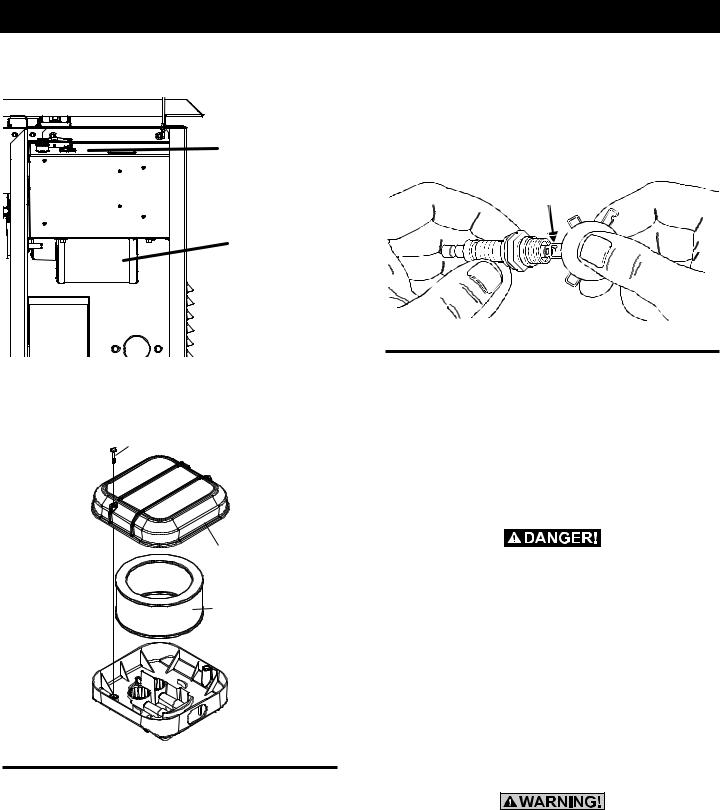
Figure 4.7 — 10kW Engine Air Cleaner
Control
Panel
Air Filter
Figure 4.8 — 13 kW and 16 kW Engine
Air Cleaner
Screw
Cover
Filter
4.5SPARK PLUG(S)
Reset the spark plug(s) gap or replace the spark plug(s) as necessary. See the Service Schedule section for maintenance requirements.
1.Clean the area around the base of the spark plug(s) to keep dirt and debris out of the engine.
2.Remove the spark plug(s) and check the condition. Replace the spark plug(s) if worn or if reuse is questionable. See the Service Schedule section for recommended inspection. Clean by scraping or washing using a wire brush and commercial solvent. Do not blast the spark plug(s) to clean.
Maintenance
3.Check the spark plug gap using a wire feeler gauge. Adjust the gap to 0.76 mm (0.030 inch) for 7 and 10kW; and 1.02 mm (0.040 inch) for 13/16 kW by carefully bending the ground electrode (Figure 4.9).
Figure 4.9 – Setting the Spark Plug Gap
4.6BATTERY MAINTENANCE
The battery should be inspected per the "Service Schedule" section. The following procedure should be followed for inspection:
1.Inspect the battery posts and cables for tightness and corrosion. Tighten and clean as necessary.
2.Check the battery fluid level of unsealed batteries and, if necessary, fill with Distilled Water Only. Do not use tap water in batteries.
3.Have the state of charge and condition checked. This should be done with an automotive-type battery hydrometer.
Do not dispose of the battery in a fire. The battery is capable of exploding.
A battery presents a risk of electrical shock and high short circuit current. The following precautions are to be observed when working on batteries:
•Remove the 15A fuse from the generator control panel.
•Remove watches, rings or other metal objects;
•Use tools with insulated handles;
•Wear rubber gloves and boots;
•Do not lay tools or metal parts on top of the battery; and
•Disconnect charging source prior to connecting or disconnecting battery terminals.
nDo not open or mutilate the battery. Released electrolyte has been known to be harmful to the skin and eyes, and to be toxic.
nThe electrolyte is a dilute sulfuric acid that is harmful to the skin and eyes. It is electrically conductive and corrosive. The following procedures are to be observed:
21
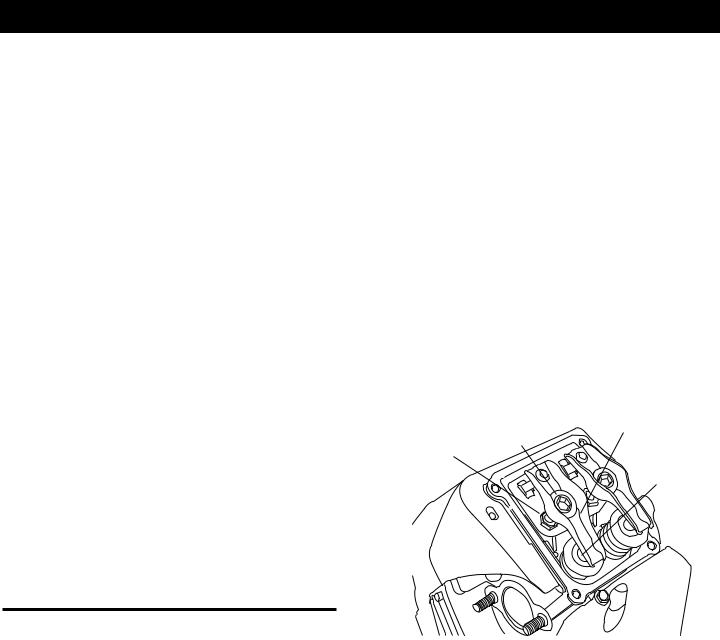
Maintenance
•Wear full eye protection and protective clothing;
•Where electrolyte contacts the skin, wash it off immediately with water;
•Where electrolyte contacts the eyes, flush thoroughly and immediately with water and seek medical attention; and
•Spilled electrolyte is to be washed down with an acid neutralizing agent. A common practice is to use a solution of 1 pound (500 grams) bicarbonate of soda to 1 gallon (4 liters) of water. The bicarbonate of soda solution is to be added until the evidence of reaction (foaming) has ceased. The resulting liquid is to be flushed with water and the area dried.
Lead-acid batteries present a risk of fire because they generate hydrogen gas. The following procedures are to be followed:
•DO NOT SMOKE when near the battery;
•DO NOT cause flame or spark in battery area; and
•Discharge static electricity from body before touching the battery by first touching a grounded metal surface.
nBe sure the AUTO/OFF/MANUAL switch is set to the OFF position before connecting the battery cables. If the switch is set to AUTO or MANUAL, the generator can crank and start as soon as the battery cables are connected.
Be sure the utility power supply is turned off and the 15A fuse is removed from the generator control panel, or sparking may occur at the battery posts as the cables are attached and cause an explosion.
4.7ADJUSTING GH-410/GT-530/990
VALVE CLEARANCE
After the first six (6) months of operation, check the valve clearance in the engine, adjust if necessary.
Important: If feeling uncomfortable about doing this procedure or the proper tools are not available, please contact the Authorized Dealer for service assistance. This is a very important step to insure longest life for the engine.
To check valve clearance:
•The engine should be cool before checking. If valve clearance is 0.002" - 0.004" (0.05 - 0.1mm), adjustment is not needed.
•Remove spark plug wires and position wires away from plugs.
•Remove spark plugs.
•Make sure the piston is at Top Dead Center (TDC) of its compression stroke (both valves closed). To get the piston at TDC, remove the intake screen at the front of the engine to gain access to the flywheel nut. Use a large socket and socket wrench to rotate the nut and hence the engine in a clockwise direction. While watching the piston through the spark plug hole. The piston should move up and down. The piston is at TDC when it is at its highest point of travel.
To adjust valve clearance (if necessary):
•Make sure the engine is at 60° to 80° F.
•Make sure that the spark plug wire is removed from the spark plug and out of the way.
•Remove the four screws attaching the valve cover with a #2 or #3 Phillips screwdriver.
•Loosen the rocker jam nut. Use an 10mm allen wrench to turn the pivot ball stud while checking clearance between the rocker arm and the valve stem with a feeler gauge. Correct clearance is 0.002-0.004 inch (0.05-0.1 mm).
Figure 4.10 - Valve Clearance Adjustment
Rocker
Pivot Ball Arm
Stud
Jam Nut
Valve
Stem
NOTE:
Hold the rocker arm jam nut in place as the pivot ball stud is turned.
When valve clearance is correct, hold the pivot ball stud in place with the allen wrench and tighten the rocker arm jam nut. Tighten the jam nut to 174 in/lbs. torque. After tightening the jam nut, recheck valve clearance to make sure it did not change.
•Install new valve cover gasket.
•Re-attach the valve cover.
NOTE:
Start all four screws before tightening or it will not be possible to get all the screws in place. Make sure the valve cover gasket is in place.
•Install spark plugs.
•Re-attach the spark plug wire to the spark plug.
•On the GT-530 and GT-990, repeat the process for the other cylinder.
22
